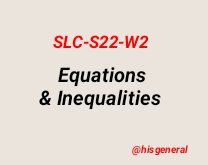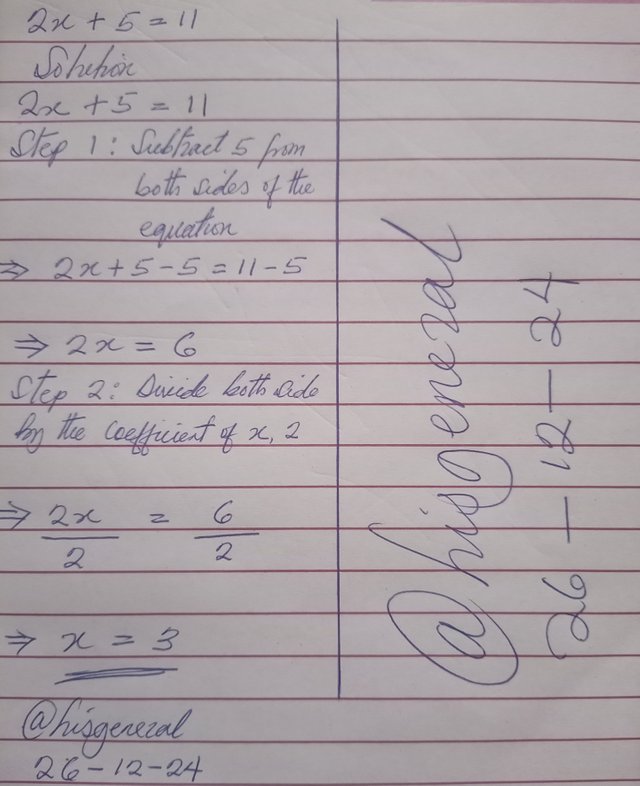SLC-S22W2/Equations and Inequalities
Hello everyone welcome once again to my blog.

Task 1
Linear Equations
Linear equations are defined as equations where the highest power of the variable(s) is always 1. The general form of linear equations can and must be expressed in the following form:
ay + b = 0
Where a and b are constants and y is the variable.
Example of Linear Equation
4y - 8 = 0
In the above example, a = 4 and b = 8 are the constants, while y is the variable.
Linear Equation can be in the form of a simple linear equation just like the example given 4y - 8 = 0, it can be a linear equation with two variables like 3x + 4y = 0, and it can also be linear inequalities like 3x - 2 > 0
Linear equations are unequivocally represented by straight lines on a graph and are characterized by having a single solution. They can be solved effectively using graphical methods or through fundamental arithmetic operations such as addition, division, multiplication, and subtraction.
Quadratic Equation
The quadratic equation, on the other hand, can be said to be a polynomial equation of degree two; in other words, the highest power of the variable, which is usually x, is two. The general form of a quadratic equation is
ax² + bx + c =0
Where a, b, and c are constants and a ≠ 0, and x is the variable
A quadratic equation can be a simple quadratic equation such as x² + 2x + 4 = 0, or a quadratic equation with a complex solution such as x² + 3x + 3 = 0, or a quadratic equation with no real solution such as x² + 1 = 0
Quadratic equations can be solved by the factorization method or by using the quadratic formula x = (-b ± √(b² - 4ac))/2a, by completing the square method, or by the graphical method.
Difference Between Linear And Quadratic Equations
| Aspect | Linear Equations | Quadratic Equations |
|---|---|---|
| Highest variable power | Has 1 as the highest power | Has 2 as the highest power |
| General form | Has the general form of ax + b = 0 | Has the general form of ax² + bx + c = 0 |
| Graphical representation | Represented by straight lines | Represented by parabolas |
| Number of solutions | Typically have one solution | Have two solutions, real & complex |
Task 2
1. Quadratic Inequalities:
This is a type of inequality in which a quadratic expression is involved. They are generally Written in the form of ax² + bx + c >, <, ≥, ≤ 0.
Where a, b, c are the constants while x is the variable.
Example 1.
x² + 4x + 4 > 0
Solution
We will need to factor the quadratic expression to solve this inequality::
= (x + 2)² > 0
Therefore, the inequality is true for values of x except x = -2.
Example 2.
x² - 4x - 5 < 0
Solution
We also need to factor the quadratic expression to solve this inequality:
= (x - 5)(x + 1) < 0
Therefore the inequality is true for values of x between -1 and 5.
2. Absolute Value Inequalities
These are inequalities in which absolute value expressions are involved. Generally, they take the form of:
|ax + b| >, <, ≥, or ≤ c
Where a, b, c are the constants while x is the variable.
Example 1.
|4x + 4| > 12
Solution
To solve this inequality, we will have to split it into two separate inequalities:
= 4x + 4 > 12 or 4x + 4 < -12
= 4x > 12 - 4 or 4x < - 12 - 4
= 4x > 8 or 4x < -16
= x > 8/4 or x < -16/4
= x > 2 or x < -4
Therefore solving these inequalities separately, we have:
x > 2 or x < -4
Example 2.
|x - 3| ≤ 1
Solution
To solve this inequality, we will also have to split it into two separate inequalities:
x - 3 ≤ 1 and x - 3 ≥ -1
= x ≤ 1 + 3 and x ≥ -1 + 3
= x ≤ 4 and x ≥ 2
Therefore, solving these inequalities separately, we have:
x ≤ 4 and x ≥ 2
Therefore, the solution to the inequality is 2 ≤ x ≤ 4.
Task 3

Application In Real Life Scenario
Cost Calculation:
Supposing Tom plans to buy a new phone that costs $11. He has a discount coupon of $5 and requires to know how much he should pay in cash (2x).
With the use of the equation, we can calculate that Tom is required to pay $6 in cash.
Task 4
Scenario: Tom's Bakery
Tom's bakery is a most famous bakery of tow and it's famous for its yummiest pastries and bread. Tom which is owner want for making sure that he has sufficient ingredients for meeting needs for his famous chocolate cake and chocolate cake recipe needs 2 cups of flour, 1 cup of sugar and 1/2 cup of cocoa powder for each cake.
| Equation | If Tom wants for making x cakes and he has 10 cups of flour, 8 cups of sugar and 4 cups of cocoa powder then calculate number of cakes that can be made by Tom? |
|---|
Equation
Forming an equation would require considering the ingredients needed for each cake as well as the total amount of available ingredients.
• Flour: 2 cups per cake, available cups = 10
• Sugar: 1 cup per cake, available cups = 8
• Cocoa powder: ½ cup per cake, available cups = 4
We can derive the following equations:
• Flour => 2x ≤ 10
• Sugar => x ≤ 8
• Cocoa powder => (½)x ≤ 4
These equations need to be solved to find the number of cakes Tom can make
Solution
• Flour:
= 2x ≤ 10
= 2x ≤ 10
= x ≤ 10/2
= x ≤ 5
• Sugar:
x ≤ 8
• Cocoa powder
(½)x ≤ 4
= ½x ≤ 4
= x ≤ 4/½
= x ≤ 4 × 2/1
= x ≤ 8
x = 5 is the least value of x, which satisfies the three equations.
Therefore, with the available ingredients, Tom can make at least 5 cakes.
Inequality
First, we need to define the variable, so let x be the number of cakes he intends to make.
The next step is to form an inequality
Since each cake requires 1 cup of sugar and Tom has 8 cups of sugar, the inequality will be:
x ≤ 8
Nevertheless, Tom also intends to make at least 6 cakes, so this will require forming a compound inequality:
6 ≤ x ≤ 8
The final step will be to solve the inequality
Solution
This is simply all values of x between 6 and 8, inclusive.
Therefore, with the available sugar, Tom can make at least 6 cakes and, at most, 8 cakes.
Scenario: Number of gallons Ashley needs.
Suppose there's a person named Ashley who is planning for a road trip from City A to City B. If I talk about distance between two cities then it's around 240 miles. Ashley's car fuel tank have ability of holding 12 gallons of gas. Suppose that his car gets 20 miles for each gallon then how many gallons of gas may Ashley purchase if he already has 2 gallons in his tank and he wants to have minimum 1 gallon left over when he arrives at City B?
| Equation | Let's consider x as number of gallons of gas Ashley can purchase. |
|---|
| Inequality | x + 2 ≥ (240/20) - 1 |
|---|
Equation
Step 1: First, we need to find the total amount of gas required for the trip thus:
Total distance = 240 miles
Miles per gallon = 20
Total required gas = Total distance / Miles per gallon
Total required gas = 240/20 = 12
Total required gas = 12 gallons
Step 2: The amount of gas Ashley already has = 2 gallons
Step 3: The amount of gas Ashley wants to have leftover = 1 gallon
Step 4: We can now form an equation taking x as the number of gallons of gas Ashley can purchase.
The sum of the gas he has (2 gallons), the gas he purchases (x), and the gas he wants as leftover (1 gallon) will make the total amount of gas he will have.
Since his tank holds only 12 gallons, the equation will be:
2 + x + 1 ≤ 12
Collecting like terms, we will get
x + 1 + 2 ≤ 12
x + 3 ≤ 12
Subtracting 3 from both sides
x + 3 - 3 ≤ 12 - 3
x ≤ 9
Therefore, since x ≤ 9, Ashley can purchase 9 gallons of gas.
Inequality x + 2 ≥ (240/20) - 1
Solution
x + 2 ≥ (240/20) - 1
Step 1: clear the bracket
x + 2 ≥ 12 - 1
Step 2: collect like terms
x ≥ 12 - 1 - 3
x ≥ 8
Therefore, since x ≥ 8, the minimum number of gallons of gas Ashley requires to purchase is 8 gallons.
Cc: @khursheedanwar
Thank you
Am inviting @missyleo, @caramella111, and @eveetim
I doff my cap for you. Wow! I commend your great knowledge of mathematics. I appreciate your invitation, but you see me, I know nothing about equations.
Great job.
Thanks, dearest friend for coming along. Mathematics is one course I find very interesting, give equations a trial and you'll enjoy it
Nice, the most difficult for me. Great job 👍
🤣🤣🤣
Wow brother you have taken your time to write down this and I wish you luck and success in this contest
Thanks, dear for coming along